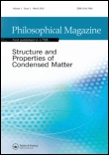
PHILOSOPHICAL MAGAZINE
Scope & Guideline
Exploring the Depths of Condensed Matter Physics
Introduction
Aims and Scopes
- Materials Characterization and Properties:
The journal emphasizes studies that investigate the structural, electronic, magnetic, and thermal properties of materials. Research often employs advanced characterization techniques and theoretical models to understand material behavior at the atomic or nanoscale. - Computational and Theoretical Approaches:
A significant portion of the published work utilizes computational methods, including first-principles calculations, Monte Carlo simulations, and phase field modeling. These approaches are used to predict material behavior and guide experimental research. - Nanostructured and Advanced Materials:
Research addressing the synthesis and application of nanostructured materials is prominent. This includes the exploration of novel composites, alloys, and nanostructures with tailored properties for specific applications. - Phase Transformations and Microstructural Evolution:
The journal covers studies on phase transformations, recrystallization, and microstructural evolution in materials under various conditions, including thermal and mechanical treatments. - Multifunctional and Smart Materials:
Research on materials that exhibit multifunctional properties, such as magnetocaloric, piezoelectric, or thermoelectric effects, is a core focus, reflecting the demand for smart materials in technology.
Trending and Emerging
- Machine Learning and AI in Materials Science:
The application of machine learning and artificial intelligence for predicting material properties and behaviors is gaining traction. This trend represents a significant advancement in how researchers approach material discovery and optimization. - Sustainable and Green Materials:
There is an increasing focus on developing sustainable materials and processes, reflecting global concerns about environmental impact. Research in this area includes the study of bio-based materials and recycling practices. - Multiscale Modeling:
Emerging research emphasizes multiscale modeling approaches that integrate different scales of materials behavior, from atomic to macroscopic levels. This reflects a growing recognition of the complexity of material systems. - Quantum Materials and Devices:
Research on quantum materials and their potential applications in quantum computing and advanced electronics is on the rise. This emerging theme highlights the intersection of materials science with cutting-edge technology. - Hybrid and Composite Materials:
The study of hybrid and composite materials that combine different functionalities and properties is becoming increasingly popular, driven by the need for advanced materials in various applications, including aerospace and electronics.
Declining or Waning
- Traditional Metallurgy:
Research focused on conventional metallurgical practices and basic alloy systems has decreased. The trend is moving toward more complex materials and advanced processing techniques, which offer enhanced properties and functionalities. - Macroscopic Mechanical Properties:
Studies primarily concentrating on the macroscopic mechanical properties of materials without a strong connection to microstructural analysis have waned. The emphasis is now more on understanding the underlying mechanisms at the micro or nano level. - Static Analysis of Materials:
Static analyses that do not incorporate dynamic or time-dependent factors are appearing less frequently. There is a growing interest in understanding materials under dynamic loading conditions and their response to environmental factors.
Similar Journals

LIQUID CRYSTALS
Bridging Chemistry and Physics in Liquid Crystal ResearchLIQUID CRYSTALS, published by Taylor & Francis Ltd, is a premier academic journal dedicated to the interdisciplinary study of liquid crystal materials and their applications. Established in 1986, this journal has become a vital platform for researchers and professionals alike, contributing to advancements in chemistry, condensed matter physics, and materials science, as reflected in its notable impact factors and ranked status in multiple categories, including Q2 in Chemistry and Q3 in Condensed Matter Physics as of 2023. With a focus on innovative research and practical applications, LIQUID CRYSTALS spans a broad spectrum of topics, including but not limited to liquid crystal displays, photonics, and soft matter physics, making it an essential resource for those exploring the frontiers of liquid crystal technology. While the journal operates under a traditional access model, the rich insights and cutting-edge findings it publishes serve to greatly benefit researchers, professionals, and students in the field. Access the journal's content to stay updated on groundbreaking developments from 1986 to 2024 and join a community committed to scientific excellence.
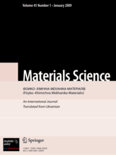
MATERIALS SCIENCE
Advancing the Frontiers of Materials Science.MATERIALS SCIENCE, a prominent journal published by SPRINGER, serves as a vital resource for researchers, professionals, and students in the fields of materials science, mechanical engineering, and condensed matter physics. With its ISSN 1068-820X and E-ISSN 1573-885X, this journal has been dedicated to sharing innovative research since its inception in 1993, and it continues to publish groundbreaking findings through 2024. Although it operates as a traditional subscription-based journal, its ranking in the Q3 quartile across multiple scientific categories, including Condensed Matter Physics, Materials Science, Mechanical Engineering, and Mechanics of Materials, signifies its relevance and impact in the academic community. Notably, its Scopus classifications reveal a competitive standing among its peers, ranking within the 25th to 33rd percentiles across various engineering and physics disciplines. The journal remains a key platform for disseminating valuable insights, fostering collaboration, and advancing the understanding of materials science.

REVIEWS ON ADVANCED MATERIALS SCIENCE
Advancing the Frontiers of Materials KnowledgeREVIEWS ON ADVANCED MATERIALS SCIENCE, published by De Gruyter Poland SP Z O O, is a preeminent open-access journal dedicated to disseminating cutting-edge research in the fields of condensed matter physics, materials science, and nanoscience. Since its inception in 2003, the journal has established itself as a crucial platform for scholars and practitioners to share innovative insights and advancements, achieving a commendable Q2 ranking in its respective categories for 2023. With its headquarters in the Russian Federation, the journal is not only committed to expanding the frontiers of scientific knowledge but also emphasizes inclusivity through its open-access model, which has been in effect since 2019, enabling universal access to its high-quality content. With an impactful standing illustrated by its Scopus rankings—136th in Condensed Matter Physics and 186th in General Materials Science—REVIEWS ON ADVANCED MATERIALS SCIENCE stands as a vital resource for researchers, professionals, and students eager to engage with contemporary discussions and discoveries in materials science.

MATERIALS SCIENCE-POLAND
Advancing the Frontiers of Materials ScienceMATERIALS SCIENCE-POLAND, published by SCIENDO, is an esteemed open access journal dedicated to the rapidly evolving field of materials science. Since its inception in 2002 and transitioning to an open access model in 2015, the journal has been a vital platform for researchers and professionals to disseminate their findings and contribute to the scientific community. With an ISSN of 2083-134X and an E-ISSN of 2083-134X, it spans a comprehensive range of disciplines, focusing on condensed matter physics, materials science, and mechanical engineering among others. In the 2023 rankings, it holds a position in the Q4 and Q3 quartiles across various categories, showcasing its relevance and ongoing contribution to these fields. Researchers benefit from its accessibility, enabling wider reach and engagement with contemporary topics in material innovation and applications. As the journal continues to evolve until 2024, it remains a cornerstone for scholars looking to advance their knowledge and research in materials science.

Journal of Advanced Dielectrics
Innovating the Future of Dielectrics and CompositesThe Journal of Advanced Dielectrics, published by World Scientific Publishing Co Pte Ltd, is a pivotal open-access platform since 2014 dedicated to advancing research in the fields of dielectrics, ceramics, and composites. Based in Singapore, this journal aims to bridge the gap between theoretical developments and practical applications in Electrical and Electronic Engineering, Condensed Matter Physics, and Electronic, Optical, and Magnetic Materials. With an impressive classification in the 2023 Quartile Rankings indicating its significance within its categories, and notable Scopus Rankings that highlight its impact and relevance, this journal serves as a vital resource for scholars and professionals committed to cutting-edge research and innovation. As it continues to flourish through the converging years from 2015 to 2024, the Journal of Advanced Dielectrics stands as an essential conduit for the dissemination of knowledge in advanced material sciences, making it an indispensable asset for today's research community.
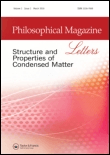
PHILOSOPHICAL MAGAZINE LETTERS
Advancing Knowledge in the Realm of MatterPHILOSOPHICAL MAGAZINE LETTERS, published by Taylor & Francis Ltd, is a prestigious open-access journal dedicated to the vibrant field of Condensed Matter Physics. With an ISSN of 0950-0839 and an E-ISSN of 1362-3036, the journal has been a pivotal platform for disseminating crucial research findings since its inception in 1981. As of 2023, it transitioned to open access, enhancing visibility and accessibility for researchers worldwide. Located in the United Kingdom, it holds a rank of #268 out of 434 in the field, placing it in the 38th percentile for its category. Its recent categorization as Q3 in Condensed Matter Physics reflects its commitment to advancing knowledge through rigorous peer-reviewed articles. The journal welcomes contributions that push the boundaries of understanding in condensed matter, fostering innovation and collaboration among physicists, professionals, and students alike. Explore groundbreaking research and join a community dedicated to the exploration of the fundamental properties of matter.
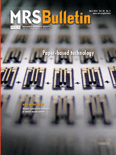
MRS BULLETIN
Connecting Researchers with Pioneering Discoveries.MRS BULLETIN is a distinguished academic journal published by Springer Heidelberg, focusing on groundbreaking research in the fields of condensed matter physics, materials science, and theoretical chemistry. With an impressive impact factor and categorizations in the top quartile (Q1) for 2023, it ranks among the leading journals in its field, demonstrating its critical role in advancing scientific knowledge and innovation. Operating from Heidelberg, Germany, this journal serves as an essential platform for the dissemination of high-quality research, synthesizing pivotal findings and discussions that bridge academia and industry. Researchers, professionals, and students will find invaluable insights within its pages, showcasing developments that are vital for fostering innovation in materials and physical sciences. Although it is not an open access journal, its rigorous peer-review process ensures the highest standards of scholarly communication, securing its reputation as a premier resource for current trends and breakthroughs.
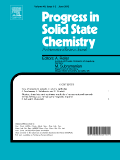
PROGRESS IN SOLID STATE CHEMISTRY
Connecting Theory and Practice in Materials SciencePROGRESS IN SOLID STATE CHEMISTRY, published by PERGAMON-ELSEVIER SCIENCE LTD, serves as a pivotal platform for disseminating cutting-edge research and advancements in the field of solid state chemistry. With an impressive impact factor and a respected status, this journal consistently ranks in the Q1 category across multiple disciplines, including Condensed Matter Physics, Materials Science, and Physical and Theoretical Chemistry. Following a rigorous peer-review process, it features articles that explore theoretical frameworks and experimental findings, thereby fostering innovation and collaboration among researchers and professionals. Although it does not adopt an open access model, its substantial reach and high Scopus rankings—19th in Condensed Matter Physics, 14th in Physical and Theoretical Chemistry, and 48th in General Materials Science—underscore its influence in shaping the future of materials research. Established in 1964, the journal continues to contribute significantly to the academic community, bridging the gap between theory and practical application in solid state materials.

Condensed Matter
Bridging Ideas in a Dynamic Scientific LandscapeCondensed Matter is a leading open-access journal dedicated to the diverse and dynamic field of condensed matter physics, published by MDPI since 2016. With its base in Switzerland, the journal aims to present a platform for researchers and professionals to share innovative findings and advancements in areas such as electronic, optical, and magnetic materials. As of 2023, it is ranked in the Q3 category for both condensed matter physics and electronic, optical, and magnetic materials, a testament to its relevance and growth within the scientific community. Researchers will find valuable insights through its accessible format, fostering collaboration and knowledge dissemination within this interdisciplinary field. With a commitment to enhancing the global dialogue in condensed matter studies, Condensed Matter invites contributions that explore theoretical and experimental approaches, thus pushing the boundaries of understanding in this crucial area of science.

Papers in Physics
Empowering researchers with open-access insights in physics.Papers in Physics is a reputable, open-access journal dedicated to advancing knowledge in the diverse fields of physics, materials science, and theoretical chemistry. Published by the Instituto de Física Líquidos y Sistemas Biológicos in Argentina, this journal has been disseminating groundbreaking research since 2009 and has quickly established its place within the academic community. With a consistent commitment to accessibility, it serves as a vital resource for professionals, researchers, and students alike, enriching the discourse with innovative studies and findings. As recognized by its 2023 Scopus rankings, the journal occupies Q3 quartile positions across several categories, including Materials Science and Physics, illustrating its relevance and impact in the scientific landscape. The journal's breadth of research encompasses interdisciplinary approaches, fostering collaboration among scholars from various domains. Whether you are seeking to publish your own research or exploring the latest developments in physics and its related fields, Papers in Physics stands as a critical platform for the dissemination of knowledge and the advancement of science.